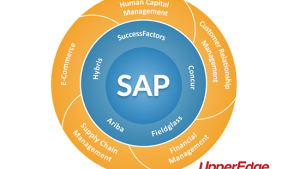- Jeff Lazarto
- Reading Time: 4 minutes

Now that the public is aware of SAP’s Indirect Access rules after the recent lawsuits with Diageo and the arbitration with Anheuser-Busch, will their competitors take note of how SAP’s licensing policies may be used as a sword to unfairly win new business over its competitors’ solutions? The answer boils down to two key questions:
1. Are there scenarios where the application of SAP’s Indirect Access licensing rules could constitute an unfair restraint on competition?
Antitrust law comprises a broad set of complex laws designed to protect consumers from a variety of anti-competitive practices. The main public policy to be furthered by antitrust law is to assure consumers the benefits of price competition and freedom of choice. Without going into all of the details regarding antitrust law which we can save for the attorneys who specialize in this area, the relevant area we intend to discuss concerns the “rule of reason” judicial doctrine.
The rule of reason doctrine provides that trade practices violate the Sherman Act only if the practice is an unreasonable restraint of trade, based on economic factors. SAP’s Indirect Access policy is not a tying agreement and illegal per se meaning that SAP is not selling software licenses on the condition that the customer buy future software licenses from SAP or not buy those products from a competitor. But could SAP’s policy, as applied, result in an unreasonable restraint of trade? In other words, could SAP’s Indirect Access licensing policy unreasonably restrain the viable options available to its customers when considering purchasing competitive products?
One of the benefits originally touted by SAP was the ability for customers to use multiple software solutions that are all interfaced or connected to operate their businesses, with much of their customer data residing on SAP as the back-end ERP system. This could occur since SAP’s software is open and can interface with any other software, and can serve as the depository and engine for managing a customer’s data.
Indirect Access, which is not defined in SAP’s agreements, occurs when a customer’s users are utilizing a non-SAP software system that is connected or interfaced in some way with SAP software, and such use extracts non-static data or somehow invokes the processing capabilities of the SAP software. In such scenarios, SAP’s claims of Indirect Access require the user to be licensed as an SAP Named User, even though the user is not logged onto the SAP software directly.
The unfair restraint on competition arises when a customer is contemplating a business solution or workstream that is outside of their current SAP solution footprint, but would be directly connected to their licensed SAP solutions.
Let’s use a customer licensed for SAP’s core ERP, who is now evaluating SAP’s Business Objects package against Oracle’s Hyperion, as a hypothetical scenario. After conducting a thorough evaluation of the capabilities of both solutions, and receiving cost proposals that are nearly identical, the customer ranks them evenly or perhaps gives a slight advantage to Hyperion. When the licensing costs are further examined considering the interface to SAP’s core ERP, the customer realizes that all business intelligence users will have to be licensed as SAP Named Users, even if Hyperion is selected, because of Indirect Access.
This scenario might unfairly tilt the balance of the selection to SAP, as a customer will determine that if all business intelligence users must be licensed as SAP Named Users regardless of the solution selected, then why choose a non-SAP package which will require even more license fees and added interface complexity? Therefore, Indirect Access as applied in this and similar hypothetical scenarios, could be deemed as an unreasonable restraint on competition and consumer freedom of choice.
2. Can a competitor prove that SAP’s Indirect Access licensing rules have in fact resulted in an unfair restraint on competition, based on economic factors?
With the public disclosure of the Diageo and Anheuser-Busch lawsuits, competitors are becoming aware of SAP’s Indirect Access rules and the impact it can have on their businesses. Therefore, we believe it is only a matter of time before competitors start to scrutinize sales opportunities they lost to SAP, where the customer already had SAP solutions installed but went through a competitive bid process to address other workflows, and look to see if the decision to select SAP was influenced by SAP’s Indirect Access licensing rules.
In determining whether a business practice violates the rule of reason doctrine, courts evaluate the totality of the circumstances to see if the challenged practice promotes or suppresses market competition.
Competitors will need to prove that while SAP customers are not contractually obligated to purchase SAP’s solutions, the effect of the application of SAP’s Indirect Access licensing rules unfairly created no financially viable alternative to selecting SAP. Further, even though the customer valued the competitors’ solutions from a capabilities and value perspective over SAP’s solutions, absent the application of Indirect Access, the competitors’ solutions were more financially competitive. Proof will also probably require SAP customers who are willing to testify that ‘if not for SAP’s Indirect Access licensing rules’ they would have selected a competitive solution, and therefore, application of SAP’s Indirect Access licensing rules suppresses, rather than promotes, competition.
This will be a tall order for competitors to prove and probably take a considerable time to accumulate enough evidence to support the claim. Further, since SAP’s Indirect Access policies do not violate a prescribed method of anticompetitive practices such as a tying agreement or exclusive supply agreement, competitors will have to prove that Indirect Access is a new means of anticompetitive behavior that unfairly restrains competition and violates the public policy of consumer freedom of choice. This is how the law evolves, by applying it to new real life factual scenarios to determine if there is an unreasonable violation of the public policy that the law is designed to protect.
SAP’s competitors would seem to have the most incentive for bringing about these claims and trying to eradicate Indirect Access. Of course, these claims could also be brought by the FTC or a state or federal attorney general’s office, or even an SAP customer or group of customers, such as ASUG. Expect the PR spin from SAP’s competitors to be that of protecting customers from SAP’s unfair business practices, but the real reason will be the competitors’ self-preservation and capitalism.
Regardless, SAP’s customers will be the ones who benefit from a successful legal claim.
However, these types of lawsuits are of little help to customers in the short-term dealing with an SAP compliance claim. The only practical solution for customers short of filing a lawsuit is to negotiate with SAP. SAP understands this dynamic and has selectively chosen specific customers to enforce Indirect Access claims while also having demonstrated a willingness to negotiate a resolution.
UpperEdge has worked on over 350 SAP engagements in contract negotiation, Indirect Access audits, and project management. Contact us here.
Related Blogs
Deloitte’s Defense Unfolds: The Contract That Could Decide the Zimmer Biomet Case
Inside SAP’s Q3 2025: Strong Cloud Growth, AI Push, and Pricing Power Plays
M&A in 2025: Prey or Potential for IT?
About the Author
